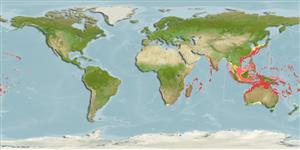Common names from other countries
Environment: milieu / climate zone / depth range / distribution range
Ecologie
marien rifbewoner; diepte 4 - 131 m (Ref. 9710), usually 9 - 130 m (Ref. 27115). Tropical; 24°C - 28°C (Ref. 27115); 40°N - 37°S, 17°E - 155°W
Indo-Pacific: East Africa (including the Mascarene Islands, Ref. 37792) to the Hawaiian and Line islands, north to southern Japan, south to Rowley Shoals, southern Great Barrier Reef and Lord Howe Island. Absent from most of central Pacific.
Grootte / Gewicht / Leeftijd
Maturity: Lm ? range ? - ? cm
Max length : 54.0 cm TL mannelijk / geslacht onbekend; (Ref. 3145); common length : 35.0 cm TL mannelijk / geslacht onbekend; (Ref. 3146); max. gerapporteerde leeftijd: 30 Jaren (Ref. 127555)
Dorsale stekels (totaal) : 9; Dorsale zachte stralen (totaal) : 25 - 27; Anale stekels: 3; Anale zachte stralen: 24 - 26. Pale brown body; broader, irregular lines on head; orange band between eyes, continued behind each eye to gill cover. Each side of caudal peduncle with single, sharp, forward-pointing erectile spine; spine largely covered by cream sheath; groove surrounded by a black area. Dorsal fin with soft part having longer base than spinous part. Minute scales. Gill rakers 22-26 in anterior row, 23-27 in posterior row. Caudal fin lunate in adults (Ref. 1602).
Schooling species, usually occurring in seaward reefs at depths greater than 9 m (Ref. 1602). Adults mainly on deep coastal reef slopes and outer reef walls, often on deep shipwrecks. Juveniles found on algae-rocky reef (Ref. 48637). Benthopelagic (Ref. 58302). Occur singly or in groups (Ref. 37816). Feed on surface film of fine green and blue-green algae, diatoms, and detritus covering sand (Ref. 1602). Pair-spawner (Ref. 37816). Mainly diurnal. (Ref. 1602). Utilized as a food fish (Ref. 3146).
Levenscyclus en paargedrag
Maturities | Voortplanting | Spawnings | Egg(s) | Fecundities | Larven
Probably spawn in pairs (Ref. 240).
Randall, J.E., 1986. Acanthuridae. p. 811-823. In M.M. Smith and P.C. Heemstra (eds.) Smiths' sea fishes. Springer-Verlag, Berlin. (Ref. 3145)
Status op de Rode Lijst van het IUCN (Ref. 130435)
CITES (Ref. 128078)
Not Evaluated
Gebruik door de mens
Visserij: van minder commercieel belang; Aquarium: Commercieel
Tools
Speciale rapporten
Download XML
Internetbronnen
Estimates based on models
Preferred temperature (Ref.
115969): 20.3 - 28.9, mean 27.2 (based on 2904 cells).
Fylogenetische diversiteitsindex (Ref.
82804): PD
50 = 0.5000 [Uniqueness, from 0.5 = low to 2.0 = high].
Bayesian length-weight: a=0.03020 (0.01872 - 0.04873), b=2.94 (2.80 - 3.08), in cm Total Length, based on LWR estimates for this species & Genus-body shape (Ref.
93245).
Trofisch niveau (Ref.
69278): 2.0 ±0.00 se; based on food items.
Weerstandsvermogen (Ref.
120179): laag, minimale populatieverdubbelingstijd 4,5-14 jaar (tmax=28; K=0.29).
Fishing Vulnerability (Ref.
59153): Moderate vulnerability (36 of 100).
